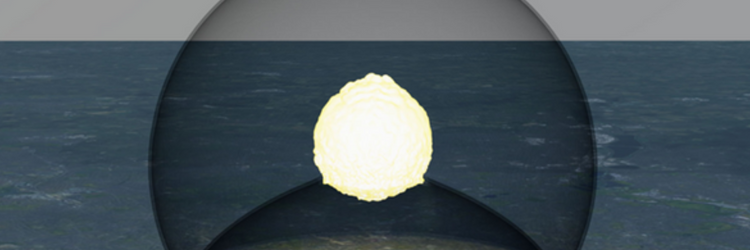During the cold war between the U.S. and Soviet Union (USSR), people built fallout shelters to protect themselves from the radiation possible in a nuclear attack. Public buildings also housed fallout shelters. We taught our children to hide under their desks if the worst happened while they were at school.
There’s an adage that says, “The more things change, the more they stay the same.”
Here we are in 2023, and researchers from the University of Nicosia are telling us there’s no good place to be when a nuclear bomb goes off. The above graphic is a 3D illustration of the simulated air blast and generated blast wave 10 seconds following the detonation of a 750 kT nuclear warhead above a typical metropolitan city. The radius of the shock bubble at ground level is 4.6 km.
Anything too close to the detonation point is vaporized instantly (Terminator 2, anyone?), and radiation will cause serious health threats even at a distance. And there is another danger: the blast wave generated by the explosion, which can produce airspeeds strong enough to lift people into the air, causing serious injury. The research is published in Physics of Fluids by AIP Publishing.
Researchers simulated an atomic bomb explosion from a typical intercontinental ballistic missile and the resulting blast wave to see how it would affect people sheltering indoors.
In a moderate damage zone, the blast wave will topple some buildings and injure people that are outdoors. Sturdier buildings, such as concrete structures, can remain standing.
The team used advanced computer modeling to study how a nuclear blast wave speeds through a standing structure. Their simulation featured rooms, windows, doorways, and corridors, allowing them to calculate the speed of the air following the blast wave and determine the best and worst places to be. The study shows that high airspeeds remain a considerable hazard and can still result in severe injuries or even fatalities.
Simply being in a sturdy building isn’t enough to avoid risk. Tight spaces can increase airspeed, and the blast wave causes air to reflect off walls and bend around corners. In worst cases, this can produce a force equivalent to 18 times a human’s body weight.
The most dangerous critical indoor locations are windows, corridors, and doors. Take shelter in the front room facing the explosion, they recommend. One can be safe from the high airspeeds if positioned at the corners of the wall facing the blast. There’s very little time to react as the time between the explosion, and the arrival of the blast wave is only a few seconds.
Post-blast, there will be increased radiation levels, unsafe buildings, damaged power and gas lines, and fires.

